Guessing about the causes and consequences of the accident Falcon 9 first of September
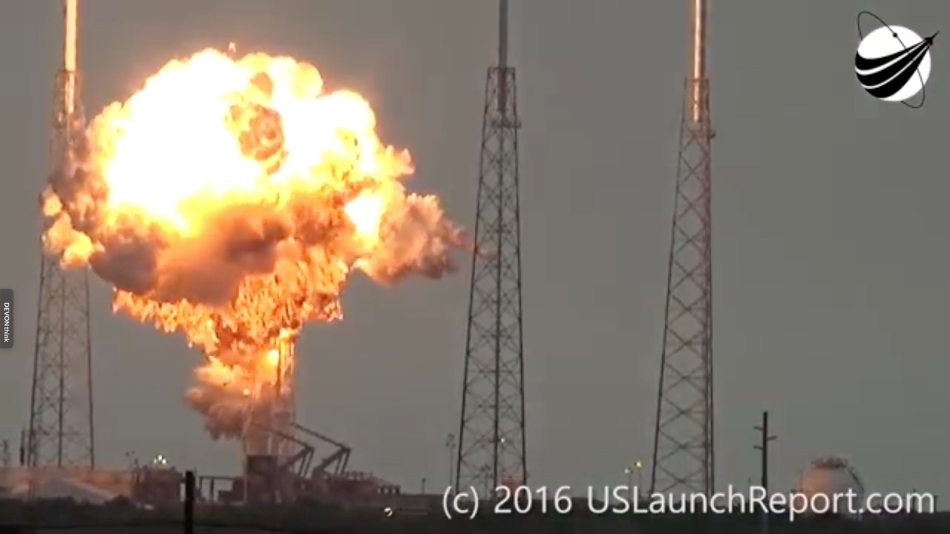
On the evening of the first of September, about eight minutes before the start of the test burn of the engines of the first stage of the Falcon 9 Full Thrust rocket, an explosion occurred in the upper part of the second stage. Together with the rocket, the payload was destroyed - the Israeli telecommunications satellite AMOS 6, as well as damage to an unknown degree of severity received the launch complex. Let's try to guess what happened and determine the consequences of this accident.
Chronology of events
September 1, 2016. The carrier rocket Falcon 9 Full Thrust is preparing for a test burn (engine start for a short time) of the first stage. A few kilometers from the start are representatives of the organization of veterans with disabilities US Launch Report, who are shooting in excellent quality.
')
About eight minutes before the test. The last "normal" frame video.

In the next frame, a big flash illuminates the rocket.

The explosion is so bright that the surroundings of the launch complex are illuminated - the lightning rod towers and the tank on the lower right.
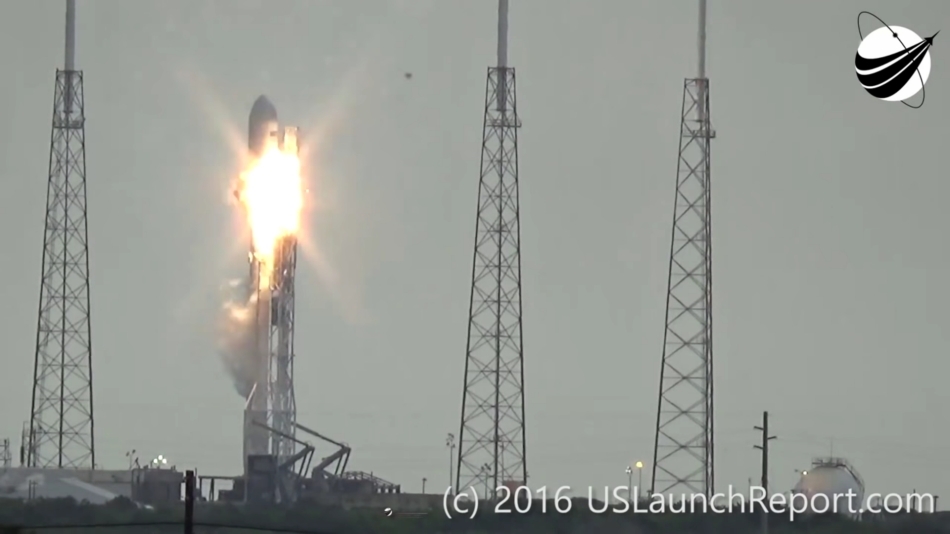
+0.15 seconds. The camera automatically adapts to the flash, it becomes clear how streams of liquid oxygen are ejected on the sides of the explosion.

+0.8 seconds The explosion noticeably spreads more in width than in height. This is logical, because at the top and bottom of the bottom of the tanks hemispherical, they are more durable, and the flat side walls are destroyed more easily. Under the cloud of liquid oxygen, kerosene flowing from the destroyed second-stage tanks becomes visible.
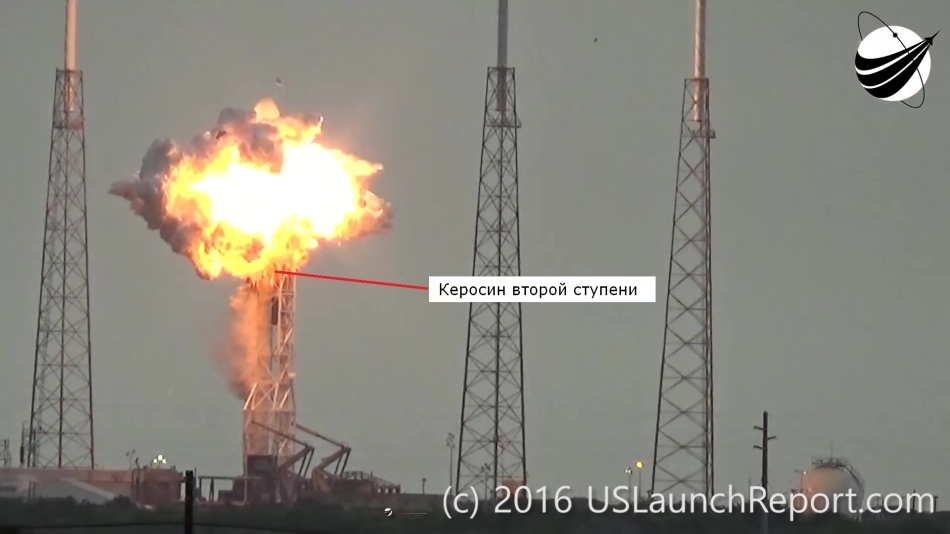
3 seconds. Pouring kerosene covers the first step. Judging by the white pair below, it has already lost strength.

In the fourth second, the first stage is finally destroyed, and the flames swell from the ignition of hundreds of tons of its fuel.
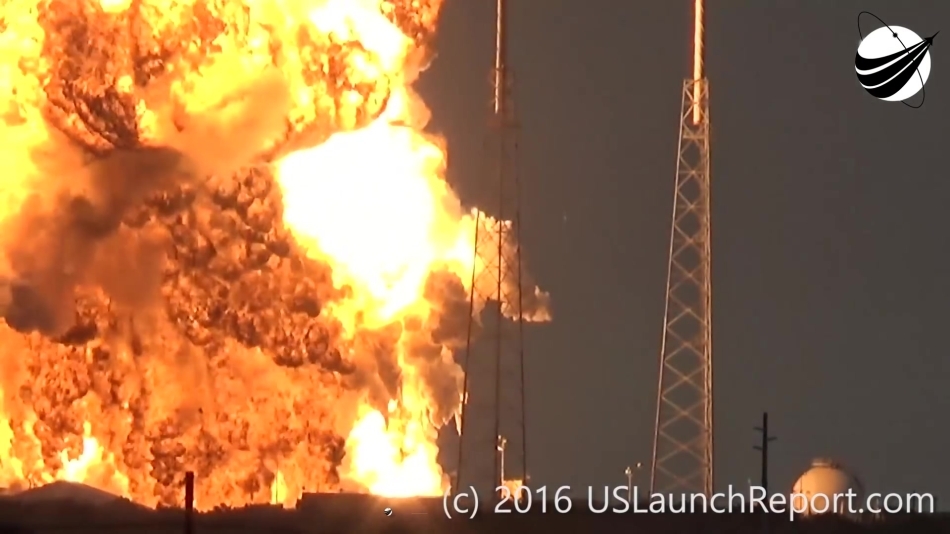
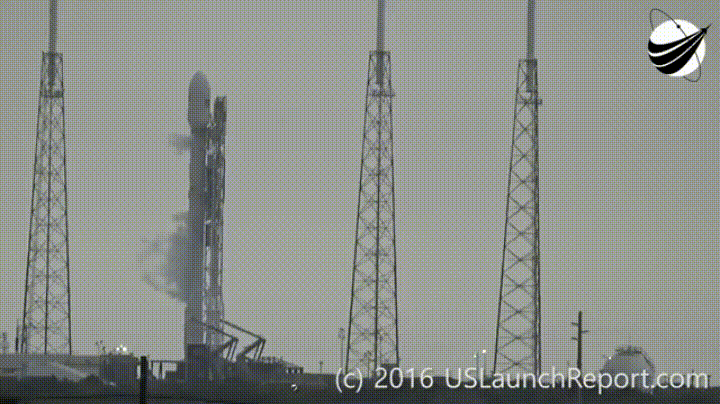
+11.5 seconds. The head fairing with a satellite falls into the flame at the launch complex.
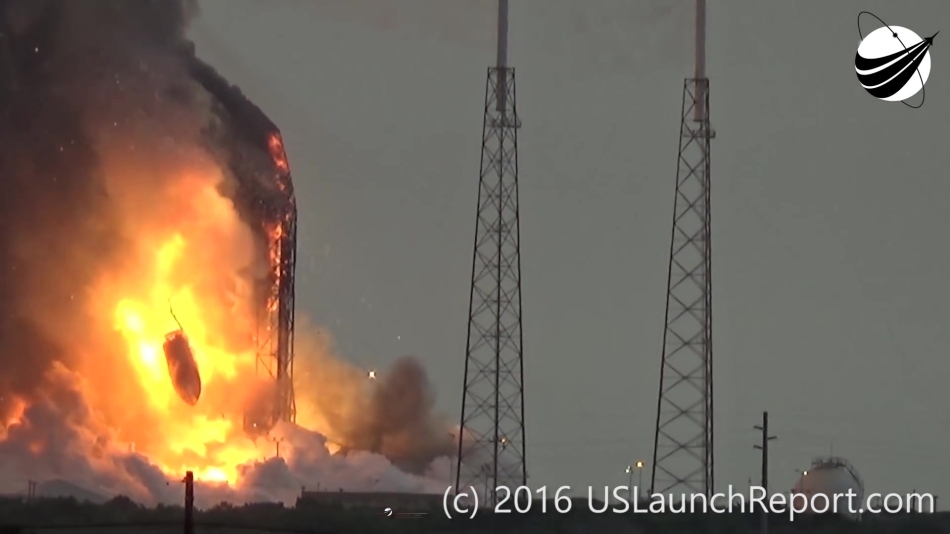
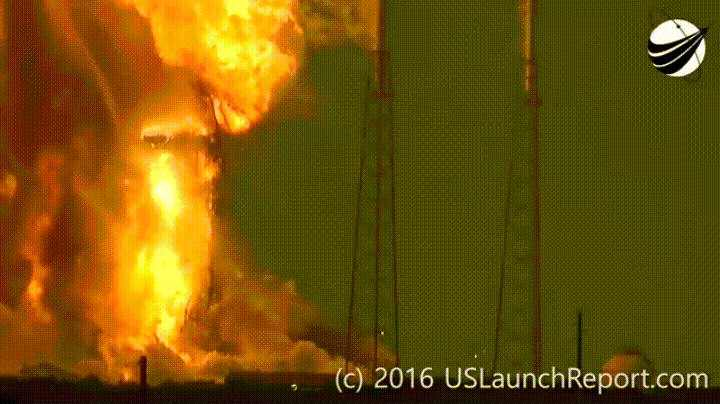
+14 seconds. The satellite’s fuel tanks are destroyed by the impact, and the flammable heptyl and amyl flames are added. The brown smoke on the left side of the frame is almost certainly amyl (nitrogen tetroxide)

A minute has passed. Kerosene burns on the launch pad.
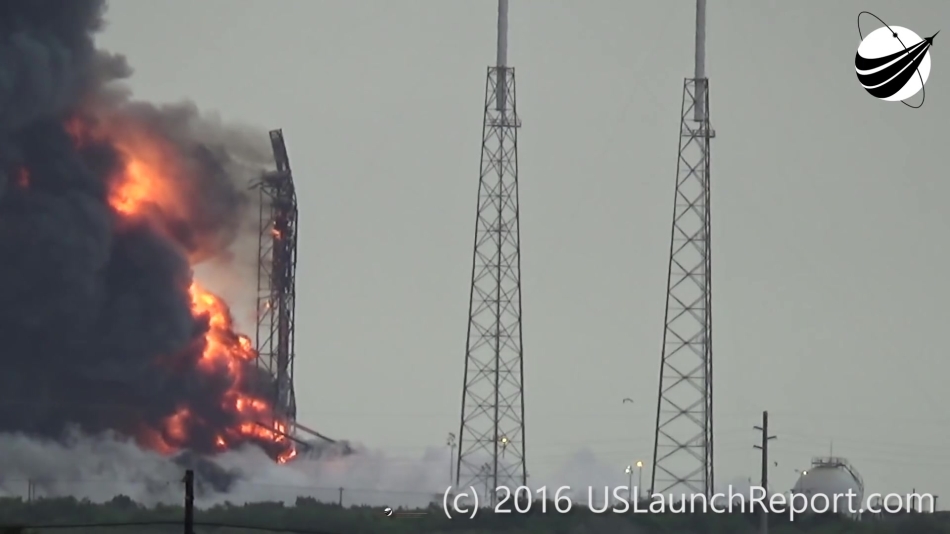
After some time, the fire goes out.

Rejection
Of course, without telemetry data, video recording and access to the launch pad, we can only guess what exactly happened. At the same time, according to the available data, it is possible to discard some versions that definitely cannot be the cause of the explosion.
UFO
The fact that a black dot was moving in the frame not far from the rocket forced some very uncritical users to say that Falcon, not much, not a little, was shot down by aliens.
If you listen to the original video, you will hear the sounds of a fairly active living fauna, and black dots will move in different directions in the frame in different directions. This black dot is most likely an insect flying close by. Less likely - a bird a little bit away. Diverse fauna regularly becomes a reason for a beautiful photo, like this magpie at the start of "ExoMars".

Destruction of the balloon gas with pressurization
A bit of a similar story happened with the second stage of the Falcon 9 last year. Mounting cylinder boost was made with violations of technology. Fastening broke, the cylinder began to shift and lost tightness. The second stage, in fact, burst from excess pressure. But in such a case, we would first see a picture of flying apart fragments and streams of liquid oxygen, and then a fire. Since kerosene and oxygen do not ignite spontaneously on contact, a powerful spark would be required for the fuel to ignite.

Turn on satellite engine
The satellite itself also has an engine. If people or equipment gave an erroneous command to start it, events would have developed differently - first they would have blown off the head fairing or an adapter between the second stage and the head fairing, and the flow of gases from the engine would be clearly visible. Accident developed too quickly for such a scenario.
Additional Information
In the photo flash you can see the four rays of illumination. For them you can try to build the exact location of the explosion on the rocket:

There are photos of this place from other launches in higher quality.

This is a photo without cropping and 3000 pixels high
On the same side from which the camera stood.

You can also find an approximate timeline of the real start. Since the burning of the first stage is as close as possible to a full-fledged test, this cyclogram should be close to what happened at the site. A plot from T-10 minutes to T-7 minutes is shown.
T-0: 10: 00 Stage 2 Venting for LOX Fast Fill - the beginning of the second stage drainage for fast filling with liquid oxygen.
T-0: 09: 50 Flight Software Final Setups complete - the latest flight software settings have been completed.
T-0: 09: 45 TEA-TEB Ignition System Setup - setting up an engine ignition system (a self-igniting mixture of triethyl aluminum-triethylborane).
T-0: 09: 45 Stage 2 Transmitter Re-Activation — re-enables the second stage transmitter.
T-0: 09: 30 M1D Trim Valve Cycling - M1D valve cyclic switching.
T-0: 09: 15 Stage 1 Helium Topping - filling of pressurized tanks.
T-0: 07: 45 MVac Fuel Trim Valve Setup - MVac fuel valve setting
T-0: 07: 30 Engine Chill Readiness - readiness for engine cooling down (there may be a pause in preparation for launch, if readiness is not reached)
T-0: 07: 00 Engine Chilldown (Bleed Valves Open, both Stages - cooling down the engines of the first and second stages - opening the drain valves.
From this list, the first operation was unequivocally carried out - the white smoke of oxygen evaporated from the tanks is clearly visible in the video. And the last two operations were definitely not performed - there was no pause in the drainage of evaporated oxygen.
Additionally, you can try to assess what is happening on the video with synchronized sound - the camera was a few kilometers away, and the sound came much later. And then the accident sounds as if the camera was very close.
And finally, it is very curious that the user of Reddit, who claims that he worked at SpaceX, confidently says that the problem is in the ground equipment, and not the rocket.
Versions
What events could cause such a powerful and rapid explosion? Versions are arranged in random order.
Component Leakage and Short Circuit
In the area of the filler holes, fuel and oxidizer components could leak. Then the short circuit ignites this mixture, it turns out a small bomb of a volumetric explosion. In favor of this version says that the accident occurred while refueling the rocket. On the other hand, leakage is not so difficult to notice, and the requirement of a second accident, a short circuit for ignition, makes such a combination less likely.
Violation of the purity of the oxygen lines
An oiled rag in an oxygen pipeline can become a source of spontaneous combustion - the oil can ignite in pure oxygen. Either a large oil stain was forgotten on the wall of the oxidizer tank. In this case, a complex chain of causes is not needed, but a serious violation (or an error in the instructions) of the personnel is required. For similar reasons in history there have been accidents with casualties among the starting team.
Leakage from the ignition system
Judging by the cyclogram, approximately at this time, the engine starting system is tuned to the self-igniting components of triethyl aluminum-triethyl borane. Leakage of these components is sufficient for ignition.
Wrong operation of the blasting system
Missiles launched from Cape Canaveral are necessarily equipped with explosion systems in case of an accident. It is not known where such charges are at Falcon 9, but an erroneous command to undermine could well provide a similar picture of the incident.
Burn or not burn
The fact that the accident occurred during the preparation for the first stage test burn, caused additional criticism of the burn as a test method for launch vehicles. In my opinion, this type of test, like any technical solution, has its pros and cons. Such a test is as close as possible to the real launch, for example, burning the Zenith could catch a problem with the onboard power source, due to which the Sea Launch accident in 2013 occurred during the first seconds of the flight. At the same time, “almost real start-up” during burning consumes additional resources of engines, valves and other things, which increases the likelihood of an accident in real flight. Yes, now everyone will advise Mask to burn only the first stage, so as not to lose the payload, but this means integrating the second stage and the payload after burning, that is, additional operations that are not checked on it. Maybe the burning was not related to this accident at all - the explosion occurred at the second stage, who knows, maybe it would also collapse on September 3 in preparation for the real launch?
And finally, it is worth noting that Musk is not the only one who uses burning of the launch vehicle at the launch facility. The same is done (temporarily, before the construction of a full-fledged test stand) Orbital with the Antares rocket. And, with all the available test equipment, they even burned through the Space Shuttle . Such a test is not a common operation, but still used in rocket technology. The main thing is to build processes so that the pros of burning outweigh the minuses.
Effects
No doubt this crash hit SpaceX very seriously. The launch complex received serious damage, at least until the end of the year there will be no new launches on it. Six of the eight planned launches of SpaceX 2016 should have been made from the destroyed launch complex, and they will definitely be seriously delayed - launches into the geostationary orbit cannot be transferred to another launch complex at the Vandenberg cosmodrome. There are some chances that the LC39A site under construction for Falcon Heavy will be ready before the repair of the damaged LC40 ends, but this, in any case, will seriously knock down the launch schedule. And if the cause of the accident is found in the rocket, its refinement will be required, and then the launches of all Falcon 9 from any space centers will be suspended until the problem is eliminated, and in the space program such periods are measured in months.
Also, Spacecom, a satellite operator, received a serious blow. At the end of 2015, AMOS 5 failed, having worked only four years instead of the estimated fifteen. And the dead AMOS 6 was supposed to be the heaviest and most powerful satellite of the group. The media has information that the accident fits into the insurance for the transportation of the satellite, so Spacecom still get insurance money, but time, alas, lost forever.
The Most Important Question
Someone may consider me a "maskophile", someone - a "maskofobom", in fact, I just try to warn against excessive fanaticism. The shock “how it could have happened in the genius of all times and peoples” and gloating “at last this rogue began to receive what he deserved” are equally erroneous. Missiles have fallen, are falling, and will fall on everyone who launches them. The question is different. The launch of AMOS 6 was to be the 29th launch of the Falcon 9 launch vehicle (modifications 1.0, 1.1 and Full Thrust). The previous accident with the loss of a satellite in 2015 was 19 on the launch. In 2013, at the fourth launch at the first stage, one of the engines collapsed, and the associated payload was lost. No matter how you think, the accident rate is still so-so. Accident AMOS 6 does not kill SpaceX, but if Mask continues to drop one rocket per year (or ten launches), then it will be very difficult for him to compete in the launch services market and for NASA contracts. And all the beautiful ideas with the re-use of the steps or the colonization of Mars, alas, are not realizable without funding from NASA and income from commercial launches.
UPD: There is information that Spacecom has demanded $ 50 million from SpaceX or a free launch, there is also information about a possible lawsuit against SpaceX. If the court really will, reputational losses may still increase.
Source: https://habr.com/ru/post/397173/
All Articles